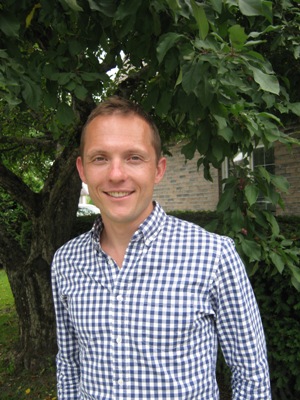
On December 1, 2017, the statewide nonprofit conservation organization, the Vermont Land Trust (VLT), will have a new President. Nick Richardson, most recently Vice President for Finance and Enterprise at VLT, will take the helm. Nick has been at VLT for more than five years and is recognized by the organization, partners and members for his creativity, hard work and passion for Vermont. “We were looking for a leader who could both build upon the rich 40-year history of VLT's conservation work and offer a fresh and compelling vision for the future,” said Walter Poleman, Chair of the VLT Board of Trustees. “After a robust national search process, the board reached the unanimous conclusion that Nick was the person for the job. He is highly creative and energetic, and is passionate about the important role VLT can play when it comes to social justice, climate resilience, and the future of the Vermont economy.”
Nick moved to Vermont in 2009, after receiving his MBA from the Tuck School of Business at Dartmouth College. Prior to joining VLT, Nick worked for Vermont Energy Investment Corporation and Encore Redevelopment (now Encore Renewable Energy), a Burlington-based renewable energy development firm. At VLT, Nick has helped accelerate the Farmland Access Program, led efforts to make forest carbon offsets viable for more Vermont forestland owners, and increased VLT’s access to capital for land conservation by expanding partnerships. Prior to moving to Vermont, Nick spent several years in Boston and Providence working for nonprofits focused on youth leadership and education reform.
The VLT Board of Trustees led a selective recruitment process for this critical and highly visible role. Rick Carbin founded VLT in 1977. Darby Bradley, then Gil Livingston, succeeded Rick; they are both recognized nationally in the land trust movement for their experience, skills and sentiment that they brought to the profession. Nick is warmly welcomed by VLT’s trustees and staff who respect his many contributions to the organization’s success.
“It’s an incredible opportunity,” said Nick. “I’m grateful to the Board of Trustees and our staff for the trust they’ve placed in me. VLT’s work over the last 40 years has positively shaped the working landscape and the character of our communities. Together, VLT and its partners, can build on this work as we continue our service to the people of Vermont. I’m excited to lead such an outstanding organization.”
“This is a momentous occasion for VLT, and as I reflect on the past, I am both humbled and inspired by all that has been accomplished,” said VLT Trustee Mary McBryde. “Our work, however, is not done. The future holds significant challenges as well as promising opportunities. Under Nick’s exciting new leadership, we will face our work with a renewed energy, creativity and determination. VLT board and staff are committed to conservation—building a resilient landscape and a strong economy and, ultimately, creating a legacy where future generations of Vermonters have deep and enduring connections to the land.”
VLT is one of the largest and most successful land trusts in the country. Established in 1977, it has conserved more than 578,000 acres, including hundreds of working farms, large stretches of working forest, and many recreations spots. In recent years, VLT’s work has taken on more of an entrepreneurial design, such as helping emerging farm business access affordable farmland, stewarding our most productive, intact forestland, and finding new ways to meet the needs of our communities related to the use of land. Increasingly, VLT’s work is focused on the areas of social justice, economic development, community engagement, and on-the-land experiences.
“VLT is fortunate to have Nick,” said Gil Livingston, VLT’s current president. “He has a big heart, he is curious and listens well, and he enjoys people. Combined with his financial and management skill, and his deep family roots in conservation, Nick will bring a distinctive perspective to an already effective land conservation organization.”

